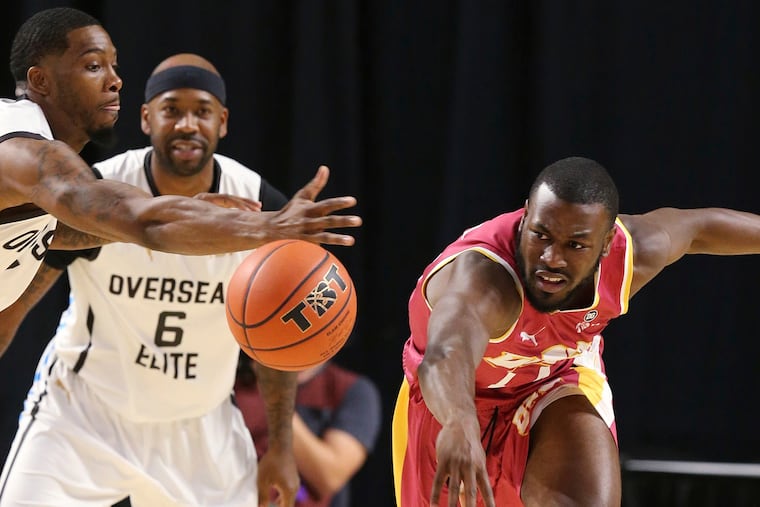The Elam Method explained, by Elam himself and the basketball players using it | Mike Jensen
There's less fouling at the end of games in The Basketball Tournament because the clock is turned off.

So, you tune in to ESPN this summer to watch a little hoops, maybe see some familiar names who played college ball around Philadelphia. Then, what is this?
The Basketball Tournament (TBT), the $2-million, winner-takes-all competition in its sixth year, now has this newfangled ending in which the game clock is completely turned off.
Announcers start to explain the Elam Method, and you want to not like it. Mess with basketball? No need for that.
Until you see how it works. And you see that it does work. The game is fair and maybe more exciting. Best part -- there’s little of the fouling that takes up the final minutes of so many games.
“The Elam Ending is essentially the way we all grew up playing pickup basketball,’’ said ESPN announcer Fran Fraschilla, an analyst for TBT games.
When the time remaining in the fourth quarter drops under four minutes, the next stoppage turns off the clock completely. Both teams are then given a target score. Take the team that is ahead, add eight points, and that’s the target. So, if somebody is leading, 57-51, after the four-minute stoppage, the first team to 65 wins.
Trust us: The concept grows on you. The clock doesn’t matter. Fouling when behind is counterproductive. But the losing team always has a chance. The clock never runs out. The shot clock still applies.
It’s sort of like tennis. You can dominate most of the way but still have to finish things off.
“I like it. I think it’s a creative way to finish a game,’’ said former Drexel star Samme Givens, a key player for Team Brotherly Love, which has won three games and will play Friday (7 p.m., ESPN) in Chicago in the TBT quarterfinals, against a team put together by Timber Creek High graduate Kyle Hines, a four-time Euroleague champion.
“An interesting wrinkle to the game,’’ Hines said.
Where did the Elam Method come from? Let’s ask Elam. (Yes, there’s an Elam.)
“I’ve watched basketball for as long as I can remember and been a big fan,’’ said Nick Elam, an educational leadership professor at Ball State.
The origins of the Elam Method, he said, go back to his days as an undergraduate at Dayton.
“Really in 2004, we first talked about this phenomenon,’’ Elam said. “My senior year, we were sitting around on [NCAA] Elite Eight Sunday. Just like we’d seen so many times, here’s this great game, then the quality of play just deteriorates at the end.”
Teams fouling, but still not coming back. Timeouts leading to nothing.
Elam is a legit Midwestern candidate for most-interesting-man in the world. He became a school teacher in Ohio, then a principal, all while working on the Cincinnati Reds grounds crew. Now that he’s in higher education near Indianapolis, he works about 20 Reds games a year. (He’s also a Mensa member.)
A few years out of college, Elam thought about what could improve late-game scenarios.
Maybe if you got rid of the game clock?
“It took a few years,’’ Elam said. “Once I convinced myself it was necessary, sound, and cool, then I really went all in on it.”
"Nick Elam sent a 50-plus-page slideshow to our info box,'' said Jake Pavorsky, a Temple graduate handling communications for the tournament. “Our founder, Jon Mugar, saw it and read it. Jon likes to say he’s the kind of guy who looks to pick something apart. Any sort of spelling or grammatical error, and he would’ve deleted it. But it was a pretty flawless presentation. We reached out to Nick. Rest is history.”
It might be too out-there to ever be seen in the NBA or Euroleague or NCAA hoops. Elam knows that. More likely, it will make its way into other levels of the game.
Daryl Morey, the general manager of the Houston Rockets, "has gone on record saying he would support implementation in the NBA,’’ Elam said.
It takes away some strategies, such as when to foul, but you could argue those aren’t true basketball strategies. It does produce alternate strategies.
“We tried to have the ball at the four-minute mark,’’ Hines said of the TBT games, since once the clock is off, an extra possession is a good thing in any scenario.
The Elam Method also makes the early portion of the fourth quarter vital, since the bigger the lead, the closer you are to winning. You better substitute accordingly.
“Coaches and teams have to prepare for it,’’ said Givens, now playing professionally in Israel, “and make the proper adjustments during the game.”
The TBT first tried it two years ago in early rounds, then went all-in last year. Elam watched all the late games with a stopwatch and determined that last year’s seven-point addition wasn’t quite enough — the games were taking less than four minutes to complete, on average — so this year, eight points are added.
“I truly believe Elam provides greater hope for comebacks,’’ Elam said.
If your head hurts from a discussion about it, watch a game. Pretty simple.
“It’s unique, and it fits TBT to a tee,’’ Fraschilla said. “It’s just like having a 17-14 lead at the Y.”